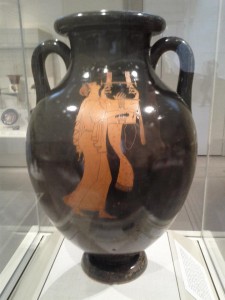A photo of what I can only think of as the Rhapsode Amphora that I took on a visit in February, 2012, to the New York Metropolitan Museum.
A personal indiscretion… if a fifty-foot tsunami hits New York, forget everything but save this amphora… The artistry of the rhapsode is so exquisite that none of the pictures I have ever seen or taken do it justice, including what the MET has available on the Internet at the link below.
Rhapsode. “A rhapsode (Greek: ῥαψῳδός, rhapsōdos) or, in modern usage, rhapsodist, refers to a classical Greek professional performer of epic poetry in the fifth and fourth centuries BC.”
Terracotta amphora (jar). Attributed to the Berlin Painter.
Period: Late Archaic Date: ca. 490 B.C. Culture: Greek, Attic ; Gallery 157, New York Metropolitan Museum.“This work is a masterpiece of Greek vase-painting because it brings together many features of Athenian culture in an artistic expression of the highest quality. The shape itself is central to the effect. Through the symmetry, scale, and luminously glossy glaze on the obverse, it offers a carefully composed three-dimensional surface that endows the subject with volume. The identity of the singer is given by his instrument, the kithara, which was a type of lyre used in public performances, including recitations of epic poetry. The figure on the reverse is identified by his garb and wand. While the situation is probably a competition, the subject is the music itself. It transports the performer, determines his pose, and causes the cloth below the instrument to sway gently.”
https://www.metmuseum.org/Collections/search-the-collections/130015398?rpp=20&pg=1&ft=56.171.38&pos=1
On the reverse, the Berlin Painter has rendered an image of the critic or judge. The picture of the critic on the MET website should not be considered as representing the same quality of artistry expended by the Berlin Painter as that on the rhapsode. The contrary is the case, including the background glazing of the vase around the critic. The rendering is indisputably of inferior quality, of *secondary* stature and importance to the Berlin Painter. In person, before this matchless vase, there can be no mistaking the difference that the judgment of the artist himself makes, and suggests, about the relationship between poetry and criticism.
I believe the Berlin Painter does imply that the ability to recognize something new and the integrity to speak words worthy of it, to bring it to the attention of the polis, if you will, the people, resides with the critic. That is the role of the critic that the Berlin Painter 2,500 years ago wrought on this exquisite amphora. That is what poetry and criticism have lost in the United States of America, if not the entire West. The proper relationship of the poet to the critic and reader has too often been replaced by all manner of dehumanizing theory, decadence, politicization, nihilism, and other corrupt conceptions of the role of the critic, losing his or her civilizing raison d’être, building civilization, rather than tearing it down, all of which have had a devastating impact on the polis.



